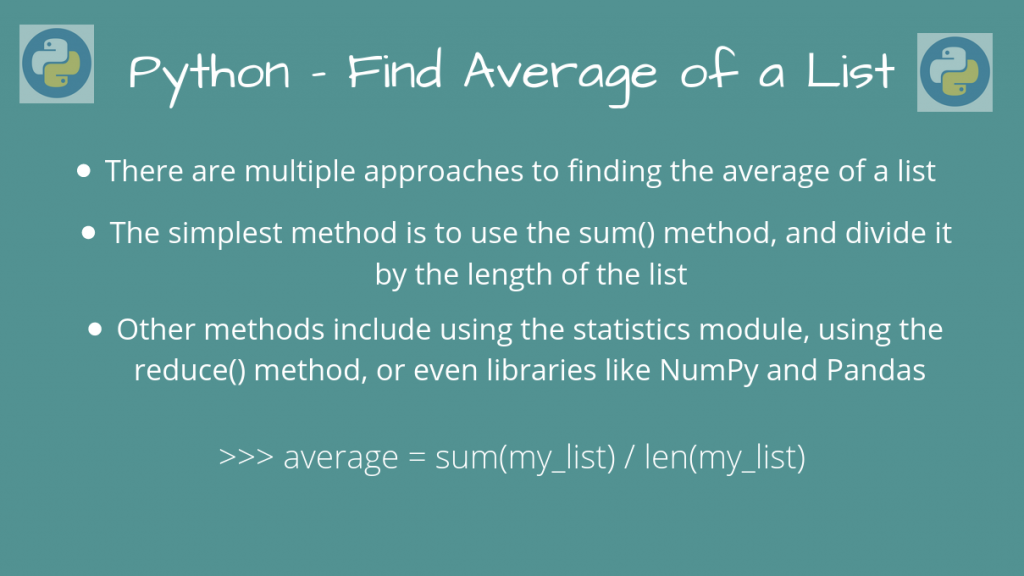There are many ways to find the average of a list in Python, provided all of them are of the same type. In this article, we’ll look at some of the methods to find the average element of a Python List.
Let’s get started!
Method 1: Use reduce() to find the average of a list in Python
We can use the reduce() method, along with a lambda function (As shown here).
We’ll sum up the elements using the lambda, and divide the result by the length of the list since average = (Sum of all elements) / (Number of elements)
So, the corresponding expression is:
average = (reduce(lambda x, y: x + y, input_list)) / len(input_list)
Let’s take a full example, to show this in action.
from functools import reduce
input_list = [3, 2, 1, 5, 7, 8]
average = (reduce(lambda x, y: x + y, input_list)) / len(input_list)
print("Average of List:", average)
Output
Average of List: 4.333333333333333
This is indeed the correct output, since the average is: (3 + 2 + 1 + 5 + 7 + 8) / 6 = 26 / 6 = 4.333
We cannot pass elements of different types, since the + operand may not work. So, all the elements of the list must be type compatible with the + operand in order for this to work. This is one of the methods we can find the average of a list in Python.
Method 2: Using the sum() method (Recommended)
Instead of using the reduce() method, we can directly find the sum using sum(list), and divide it by the length.
input_list = [3, 2, 1, 5, 7, 8]
average = sum(input_list) / len(input_list)
print("Average of List:", average)
We’ll get the same output as before!
This is the recommended method of finding the average of a list in Python, since it uses only built-in functions, and is really simple to use.
Method 3: Using statistics.mean()
For Python versions of 3.4 and above, we can also use the statistics module to find the average of a list in Python.
import statistics
input_list = [3, 2, 1, 5, 7, 8]
average = statistics.mean(input_list)
print("Average of List:", average)
Method 4: Using numpy.mean()
If you want to use NumPy based methods, numpy.mean() will do this for you.
import numpy as np
input_list = [3, 2, 1, 5, 7, 8]
average = np.mean(input_list)
print("Average of List:", average)
You can also convert the list into a numpy array, and then get the mean using ndarray.mean. You can use whichever is better for your use-case, but they perform about the same.
import numpy as np
input_list = [3, 2, 1, 5, 7, 8]
# Convert to a numpy ndarray and get the mean
# using ndarray.mean
average = np.array(input_list).mean
print("Average of List:", average)
Method 5: Using pandas Series.mean()
If you’re using Pandas, you can get the mean of a list using pandas.Series(list).mean()
import pandas as pd
input_list = [3, 2, 1, 5, 7, 8]
# Convert the list to a Pandas Series using pd.Series(list)
# and then get it's mean using series.mean()
average = pd.Series(input_list).mean()
print("Average of List:", average)
Output
Average of List: 4.333333333333333
Conclusion
In this article, we learned how we could find the average of a list in Python, using different approaches.
References
- StackOverflow Question on Finding the Average of a List
